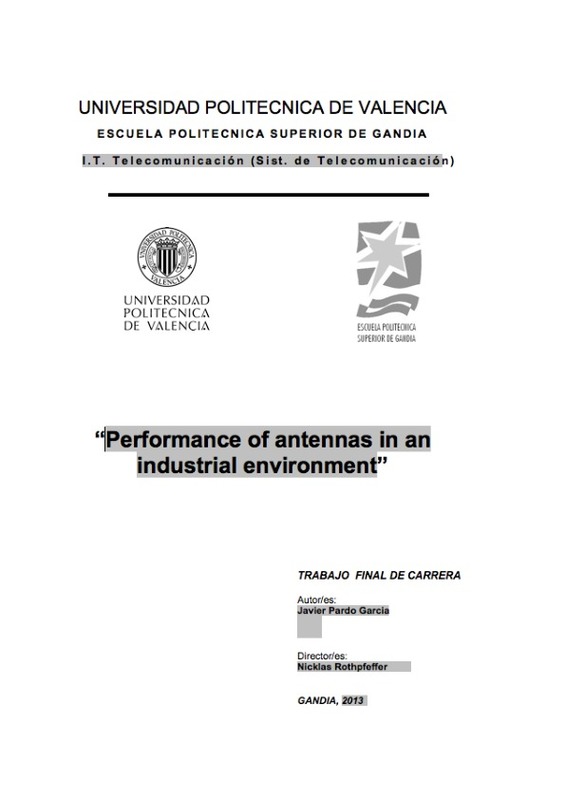JavaScript is disabled for your browser. Some features of this site may not work without it.
Buscar en RiuNet
Listar
Mi cuenta
Estadísticas
Ayuda RiuNet
Admin. UPV
Performance of antennas in an industrial environment
Mostrar el registro sencillo del ítem
Ficheros en el ítem
| dc.contributor.advisor | Flores Asenjo, Santiago José
|
es_ES |
| dc.contributor.author | Pardo García, Javier
|
es_ES |
| dc.date.accessioned | 2013-06-24T12:55:17Z | |
| dc.date.available | 2013-06-24T12:55:17Z | |
| dc.date.created | 2013-04-10 | |
| dc.date.issued | 2013-06-24 | |
| dc.identifier.uri | http://hdl.handle.net/10251/30042 | |
| dc.description.abstract | The industry is constantly growing and thus needs new applications for the future. The problems for these technologies are the main worries for the developers because in an industrial environment there are interference factors, which make use of other kind of technologies and antennas. Generally, the technologies currently used in an industry are not optimized for industrial environments although some standard organizations are working to develop future standards (ETSI). Special structures, which are used in industries, include different materials; these materials produce changes in the behavior of transmitters and receivers. Absorbent materials can reduce this problem and reduce propagation. The main goal of this project is to analyze different antennas using the software Savant, to choose the best one in an industrial environment. The analysis of antennas will simulate the usage of different antennas in an industrial environment in the frequency range of (300 MHz- 3 GHz). Further, different coats will be used to find out which one is the better one concerning the coat. By using the software Savant we will design the coating to analyze it. We will use two different kinds of coat Metal (PEC) and Single layer dielectric.Once we found the result we will look in the range of frequency 2.4 GHz and we will select the best one for calculating the losses of the difference between total field of Metal PEC and Singer layer dielectric. The study showed that the best antennas for industrial environments are the dipole and monopole ones, because both of them have low losses in this hostile environment. The sections provided during the study intend to guide the research into the important aspects that revolve around the experiment. | es_ES |
| dc.format.extent | 24 | es_ES |
| dc.language | Inglés | es_ES |
| dc.publisher | Universitat Politècnica de València | es_ES |
| dc.rights | Reconocimiento - No comercial - Sin obra derivada (by-nc-nd) | es_ES |
| dc.subject | Industrial environment | es_ES |
| dc.subject | Wireless Technology | es_ES |
| dc.subject | Standards | es_ES |
| dc.subject | Antennas | es_ES |
| dc.subject | Antenas | es_ES |
| dc.subject | Wi-fi | es_ES |
| dc.subject | Tecnologías | es_ES |
| dc.subject.classification | TEORIA DE LA SEÑAL Y COMUNICACIONES | es_ES |
| dc.subject.other | Ingeniero Técnico de Telecomunicación, esp. en Sistemas de Telecomunicación-Enginyer Tècnic de Telecomunicació, esp. en Sistemes de Telecomunicacions | es_ES |
| dc.title | Performance of antennas in an industrial environment | es_ES |
| dc.type | Proyecto/Trabajo fin de carrera/grado | es_ES |
| dc.rights.accessRights | Abierto | es_ES |
| dc.contributor.affiliation | Universitat Politècnica de València. Instituto Universitario de Telecomunicación y Aplicaciones Multimedia - Institut Universitari de Telecomunicacions i Aplicacions Multimèdia | es_ES |
| dc.contributor.affiliation | Universitat Politècnica de València. Departamento de Comunicaciones - Departament de Comunicacions | es_ES |
| dc.contributor.affiliation | Universitat Politècnica de València. Escuela Politécnica Superior de Gandia - Escola Politècnica Superior de Gandia | es_ES |
| dc.description.bibliographicCitation | Pardo García, J. (2013). Performance of antennas in an industrial environment. Universitat Politècnica de València. http://hdl.handle.net/10251/30042 | es_ES |
| dc.description.accrualMethod | Archivo delegado | es_ES |
Este ítem aparece en la(s) siguiente(s) colección(ones)
-
EPSG - Trabajos académicos [5004]
Escuela Politécnica Superior de Gandia






